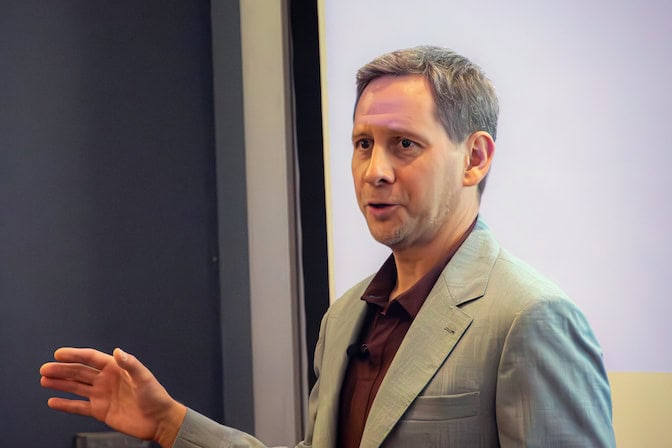
Waymo co-CEO Dmitri Dolgov discusses “prescience and patience”
The CSE alum details his journey from mathematical abstractions to vehicles safely navigating city streets.

The CSE alum details his journey from mathematical abstractions to vehicles safely navigating city streets.
In 2009, around a dozen Google engineers instrumented a Prius with off-the-shelf sensors and a PC and set out to see how hard it’d be to get the car to drive itself. University of Michigan alumnus Dmitri Dolgov (Ph.D. CSE ’08) was a co-founder of Project Chauffeur, Google’s self-driving car program.

Transportation and mobility experts
work across disciplines to build a future
that’s safe, resilient and secure.
Today he’s co-CEO of Waymo, the autonomous driving technology company ranked No. 1 on Fast Company’s 2025 World’s Most Innovative Companies list.
Waymo operates public robotaxis in Phoenix, Austin and Los Angeles in addition to the Bay Area and a swath of Silicon Valley. It logs more than 250,000 rides a week.
FastCo points to “prescience and patience” that helped Waymo “pull ahead of the rest of the autonomous field.” The Michigan Engineer chatted with Dolgov about the journey.
Dolgov: Full autonomy is one of the most complex engineering challenges of our times—it’s the software equivalent of putting a human on the moon. What sets Waymo apart is our commitment to safety and very deliberate approach to development and deployment. We have always built for the long term and had the patience to address each layer of this complex challenge. From building cutting-edge technology to turning it into a delightful product to establishing 24/7 service operations across multiple cities—this thoroughness and commitment to doing this right is what’s powered our progress.

Dolgov: In the early days, the most challenging aspect was navigating the gap between theoretical possibility and practical implementation. When we started this journey, we were trying to solve what many considered impossible with technologies that were still evolving. Every breakthrough got us closer but also revealed a new layer of complexity.
What kept us moving forward was a clear vision of the impact autonomous vehicles could have on safety, accessibility and mobility. More than 40,000 lives lost annually on US roads is an unacceptable status quo that drives our work every day.
Dolgov: Rather than a single eureka moment, our confidence has built through a series of milestones that demonstrated our progress toward truly viable autonomous driving.
One particularly significant moment came in 2015 when we offered the world’s first fully autonomous ride on public streets to a member of the public in Austin, Texas. Our rider, Steve Mahan, was legally blind, which made the experience especially meaningful as it highlighted the accessibility benefits of our technology.
A major breakthrough came in 2017 when we became the first company to deploy fully autonomous operations in Metro Phoenix—vehicles operating on public roads with no human behind the wheel. This was followed by another industry first in 2020 when we opened a paid autonomous ride-hailing service to the public in Phoenix.
But perhaps the most affirming development has been watching our service scale to the point where we’re now providing over 250,000 weekly rides across multiple cities. Seeing so many people rely on Waymo for their daily transportation needs—not as a novelty but as a practical, everyday service—has been truly validating.

A look at the next-gen semiconductors we need to power tomorrow’s fully self-driving vehicles.
More stories from
The Michigan Engineer magazine
Dolgov: A simpler way to think about autonomy is this: either you need a human driver behind the wheel, or you don’t. Everything else is nuance.
But if we stick with the Society of Automotive Engineers (SAE) framework, Waymo currently operates on Level 4—vehicles that operate without human intervention, within specific domains. Level 5, by comparison, means full autonomy anywhere, in any condition a human could drive—from remote mountain roads to extreme winter weather conditions, with no operational limitations.
I tend to avoid making specific predictions about Level 5 timelines. While additional advances in AI will enable us to gradually expand our operational domains, the real challenge isn’t tech capabilities—it’s building confidence that the technology can reliably manage any situation, in any condition. Our focus is on safely scaling our service and delivering real value to the riders who rely on it every day.
Dolgov: In plain language, it’s a mathematical way of asking: “If I take this action now and continue making decisions according to my strategy, how good will the outcome be in the long run?”
The equation appeared in my thesis when I was working on multi-agent decision making in probabilistic, or uncertain, environments, where I needed mathematical tools to evaluate different decision pathways. Years later, this same fundamental equation appears in our Waymo papers because autonomous vehicles face similar decision-making challenges—they need to evaluate countless possible actions and their long-term consequences.
What’s remarkable about seeing this equation span from my PhD thesis to recent Waymo papers is how it represents both continuity and evolution in the field. The fundamental principles behind AV planning and problem-solving haven’t changed, but our implementation and capabilities have grown drastically.
In my thesis, this was largely theoretical work applied to simplified problems. At Waymo, we’ve built upon these foundations to create large AI/machine learning models and systems that can handle the incredible complexity of real-time decision-making while driving in unpredictable environments with other road users.
This throughline in my work shows how foundational research in decision theory can ultimately transform into technology that improves people’s lives daily—a journey from mathematical abstractions to vehicles safely navigating city streets.